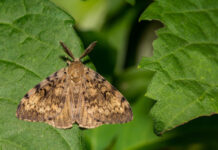 Most regions of the U.S., with a few exceptions, have experienced their first frost of the season by now. And landscapers are among that select group of people for whom that first dip into freezing temperatures means more than just it’s going to be a chilly day. An avid gardener, I watch that daily high and low with an eagle eye every fall and spring. On more than one occasion, I’ve had to drop everything and make it a priority to move all my pots indoors for the season. As a result, I’ve come to view that 32 degrees F with a sort of mysticism. It seems a dark magic must be at work to transform a vibrant, huge coleus one day into a wilted mess the very next. So what does first frost actually mean and does it end the planting season?
Most regions of the U.S., with a few exceptions, have experienced their first frost of the season by now. And landscapers are among that select group of people for whom that first dip into freezing temperatures means more than just it’s going to be a chilly day. An avid gardener, I watch that daily high and low with an eagle eye every fall and spring. On more than one occasion, I’ve had to drop everything and make it a priority to move all my pots indoors for the season. As a result, I’ve come to view that 32 degrees F with a sort of mysticism. It seems a dark magic must be at work to transform a vibrant, huge coleus one day into a wilted mess the very next. So what does first frost actually mean and does it end the planting season?
Fall Frost Forecasts
According to the National Weather Service (NOAA), hitting 32 degrees and first frost in the fall aren’t necessarily synonymous. “Frost can occur when the temperature falls below 36°F, especially in rural areas. It is a localized phenomena and can be quite variable across a small area. While the National Weather Service does not keep track of ‘frost’ in observations per se, we do keep track of when temperatures hit the freezing mark or fall below. Frost becomes more widespread when the temperature falls below 32°F with some freeze possible. A hard freeze is possible when temperatures fall below 28°F.” Here’s a breakdown of NOAA terms:
Frost Advisory: issued when temperatures, winds, and sky cover are favorable for frost development. Most likely when temperatures are less than or equal to 36 degrees. Frost coverage should be more than patchy. If a frost is sufficiently severe to end the growing season, it is commonly referred to as a ‘killing frost.’ What to do – Cover up plants before the sun sets so to help retain heat.
Freeze Warnings: issued when low temperatures are expected to be 29-32 degrees. What to do – Move sensitive plants inside.
Hard Freeze Warnings: issued when temperatures are expected to be 28 degrees or less. What to do – Sensitive plants must be moved inside because the freeze will kill them.
A color coded map from NOAA shows the average date of first freeze in regions across the U.S. A very convenient search of frost risk dates by percentage can also be found on the popular gardening site, Dave’s Garden. Simply type in your area code for information. For instance, when I typed in a NJ area code, it revealed, “Each winter, on average, your risk of frost is from October 15 through April 30. Almost certainly, however, you will receive frost from October 29 through April 17. You are almost guaranteed that you will not get frost from May 13 through October 1. Your frost-free growing season is around 168 days.” It also included charts from three NJ weather stations, provided by the National Climatic Data Center, breaking down by percentages, dates, and temperatures the probability of first freeze or last frost.
What Can Be Planted?
Of course, not all horticultural work has to cease after first frost since the soil stays warm longer than the air. Spring flowering bulbs can still be planted until the ground freezes. And while September and October are generally the best months to plant new trees and shrubs, the experts at Davey Tree say as long as the ground isn’t frozen yet, there are still some varieties that can be planted after first frost. Here is more specific advice from Davey’s arborists:
• Avoid planting evergreens after first frost. It’s difficult for them to establish roots and preserve needles with the limited water supply in winter.
• Also avoid planting birch, dogwood, willow or magnolia since they need more time to establish. Plant in spring and water throughout the summer.
• Unless your area has a mild or warm winter, hold off on planting new fruit trees until the spring so they aren’t damaged by winter weather.
• Generally, other deciduous trees and shrubs can be planted if they will have at least four to six weeks to establish roots and drink water before the soil freezes.
• Not sure about soil temps? Use a soil thermometer. If soil is consistently 50 degrees or higher, it’s safe to plant deciduous trees or shrubs.
• In areas where the ground does not freeze, late fall and winter planting can actually be ideal because trees can establish roots before hot, dry weather sets in. Here are a few*:
- Alabama: Fall is okay, but winter (November through March) is even better.
- California: Fall through winter will set your trees up for success.
- Georgia: Late fall or even winter will work. November and December are perfect.
- Hawaii: Go for the rainy season (November through March).
- Louisiana: Expand your home’s forest in November or December.
- Tennessee: Autumn (and early winter) are best.
*In Florida, you can most likely plant any time of year, but unlike the states listed above, the rainy season from May to October is best.
• If you do plant, make sure to mulch and water weekly until the ground freezes. Trees that have been planted for at least a year can be fertilized when dormant in late fall or early winter.











![[VIDEO] Dickies®: Discover Workwear That’s Anything But Uniform](https://turfmagazine.com/wp-content/uploads/2023/06/1647663814-4b1a2a7742790a9b1e97a3b963477850192e1d6a9dfba9b07214a77bae25d6e3-d-218x150.jpg)






























![[VIDEO] Dickies®: Discover Workwear That’s Anything But Uniform](https://turfmagazine.com/wp-content/uploads/2023/06/1647663814-4b1a2a7742790a9b1e97a3b963477850192e1d6a9dfba9b07214a77bae25d6e3-d-324x160.jpg)